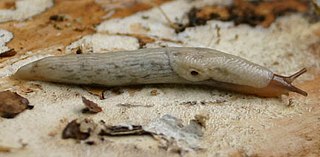
The Spanish slug is an air-breathing land slug, a terrestrial pulmonate gastropod mollusk in the family Arionidae, the roundback slugs. Other vernacular names are Lusitanian slug, Iberian slug, and killer slug.

Deroceras praecox is a species of small air-breathing land slug, a terrestrial pulmonate gastropod mollusk in the family Agriolimacidae.
Deroceras laeve, the marsh slug, is a species of small air-breathing land slug, a terrestrial pulmonate gastropod mollusk in the family Agriolimacidae.
Deroceras turcicum is a species of air-breathing land slug, a terrestrial pulmonate gastropod mollusc in the family Agriolimacidae.
Deroceras juranum is a species of air-breathing land slug, a terrestrial pulmonate gastropod mollusk in the family Agriolimacidae.

Deroceras invadens is a species of air-breathing land slug, a terrestrial pulmonate gastropod mollusc in the family Agriolimacidae. Until 2011, this widely distributed species was known as Deroceras panormitanum, and earlier as Deroceras caruanae or Agriolimax caruanae, but Reise et al. (2011) showed that these names refer to a distinct species of similar external appearance known at that time only from Sicily and Malta. Consequently, although the more widespread species was already well known, it then had to be redescribed under the new name of D. invadens. Genetic evidence has indicated that D. invadens is native in southern Italy, including parts of Sicily, and possibly parts of central Italy. Elsewhere it has been introduced, predominantly within the last 100 years, but its spread has been constrained by cold winter temperatures.

Limacus maculatus, the green cellar slug or Irish yellow slug, is a species of slug native to the Caucasus and Black Sea coast. It has also been introduced to a number of northern European countries. In its introduced range the species is often synanthropic. It is most likely to be confused with Limacus flavus, which it closely resembles externally.

Tandonia kusceri is a species of slug belonging to the family Milacidae.

Andrzej Wiktor (1931–2018) was a Polish taxonomist of terrestrial slugs. His considerable research output includes a number of comprehensive reviews that document the slug faunas of particular countries or revise the taxonomy of whole families. He worked for almost all of his career at the Museum of Natural History, University of Wrocław in Poland.






